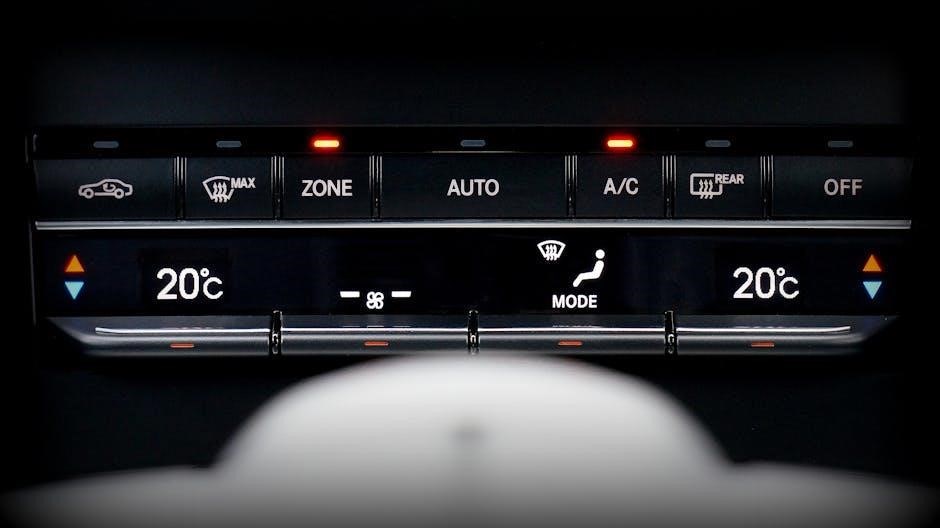Discover the powerful combination of ESP32 and HyperHDR 20 SPI for stunning high dynamic range imaging and real-time LED control․ Learn to harness SPI communication for seamless integration and vibrant visuals․

What is HyperHDR 20?
HyperHDR 20 is a high-speed, high dynamic range (HDR) sensor designed for capturing detailed images with exceptional clarity․ It combines multiple exposures to reveal details in both bright and dark areas, producing vivid results․ Ideal for real-time image processing, it supports advanced LED control and integrates seamlessly with ESP32 for efficient SPI communication, making it a powerful tool for ambient lighting and display applications․
Why Use ESP32 for HyperHDR 20?
The ESP32 is an ideal choice for HyperHDR 20 due to its high-speed SPI communication, enabling real-time data transfer and efficient LED control․ Its dual-core processor and extensive GPIO pins provide robust multitasking capabilities, while built-in Wi-Fi and Bluetooth offer versatile connectivity options․ The ESP32’s compatibility with HyperHDR’s high-speed serial driver ensures optimal performance, making it a cost-effective and powerful solution for advanced LED lighting and HDR imaging applications․
Hardware Requirements and Setup
Gather essential components: an ESP32 board, HyperHDR 20 sensor, compatible LED strips, and necessary wiring․ Ensure proper power supply and voltage-level shifting for reliable operation and connectivity․
ESP32 Board Overview
The ESP32 is a powerful microcontroller featuring built-in Wi-Fi, Bluetooth, and advanced peripherals like SPI․ Its dual-core architecture and extensive GPIO pins make it ideal for complex projects․ The ESP32 supports high-speed SPI communication, enabling efficient data transfer to HyperHDR 20 and LED strips․ Popular boards include the ESP32 DevKitC and Lolin32, offering versatile pinouts for diverse applications․ Ensure your board supports the necessary communication speeds for optimal performance․
HyperHDR 20 Sensor Setup
Setting up the HyperHDR 20 sensor involves connecting it to the ESP32 via SPI pins․ Ensure proper wiring of VCC, GND, SCK, and MOSI pins․ Configure the sensor settings in the HyperHDR software, specifying resolution and frame rate․ Calibrate the sensor for accurate light detection․ Verify SPI communication is enabled and functioning correctly․ This setup allows the sensor to capture high dynamic range data, essential for real-time image processing and LED strip control․
LED Strip Configuration
Configure your LED strip by selecting the appropriate type, such as WS2812B or SK6812, in the HyperHDR software․ Ensure the strip is powered externally and connected to the ESP32’s GPIO pins․ Define the strip’s length and layout in the configuration settings․ Use a voltage level shifter if necessary to match the ESP32’s 3․3V output․ Proper configuration ensures smooth communication and accurate color reproduction for ambient lighting effects․
Software Setup and Installation
Install ESP32 support in Arduino IDE and configure HyperHDR software for seamless integration․ Use PlatformIO for advanced settings and optimize serial communication for high-speed data transfer efficiency․
Installing ESP32 Support in Arduino IDE
To work with ESP32, install the ESP32 Board Support package in Arduino IDE․ Navigate to File > Preferences, add the JSON URL in Additional Boards Manager URLs, and install the latest ESP32 package․ Select the correct ESP32 board from Tools > Board and configure settings like baud rate and partition scheme․ This setup enables seamless programming and communication with the ESP32 for HyperHDR projects․
Setting Up HyperHDR Software
Download and install HyperHDR from the official website․ Launch the software and configure the initial settings, selecting the video capture device and output settings․ Choose the desired resolution and frame rate, ensuring compatibility with your LED setup․ Use the built-in tools to generate commands for seamless control․ Optimize synchronization settings for smooth performance․ Explore advanced features like real-time image capture and ambient lighting integration․ Test the configuration to ensure proper functionality and vivid LED effects․

SPI Communication with ESP32
ESP32’s SPI interface enables high-speed data transfer, ideal for real-time applications․ It supports multiple devices and custom pin configurations, ensuring efficient communication for HyperHDR 20 integration․
Understanding SPI Protocol
SPI (Serial Peripheral Interface) is a synchronous serial communication protocol enabling high-speed data transfer between devices․ It uses a master-slave architecture with four pins: MISO (Master In, Slave Out), MOSI (Master Out, Slave In), SCK (Clock), and SS (Slave Select)․ Data is transmitted full-duplex, allowing simultaneous sending and receiving․ SPI’s fast data rates make it ideal for real-time applications like HyperHDR 20, ensuring efficient and reliable communication with minimal lag in image processing and LED control․
Configuring ESP32 SPI Pins
Configuring ESP32 SPI pins involves defining MOSI, MISO, SCK, and SS pins for communication․ While default pins are often used, custom configurations are possible for flexibility․ Ensure the ESP32 operates in master mode for HyperHDR 20, enabling control over peripheral devices․ Proper pin setup guarantees efficient data transfer and real-time communication, crucial for high-speed applications like LED control and image processing․

Configuring HyperHDR 20 with ESP32
Connect HyperHDR 20 to ESP32 via SPI, ensuring proper pin alignment and configuration․ Follow software setup guides for seamless integration, enabling precise control and optimal performance․
Connecting HyperHDR 20 to ESP32
Start by identifying the ESP32’s SPI pins (MISO, MOSI, SCK, and CS)․ Connect the HyperHDR 20 sensor to these pins, ensuring proper alignment and voltage compatibility․ Use a level shifter if necessary to match voltage levels․ Securely attach the sensor to the ESP32 board, verifying all connections․ This setup enables high-speed data transfer via SPI, allowing the ESP32 to accurately capture and process data from the HyperHDR 20 sensor․
Setting Up HyperHDR 20 in Software
Install the HyperHDR software and navigate to its configuration menu․ Select the ESP32 HyperHDR 20 SPI profile to enable proper communication․ Use the built-in tool to generate necessary commands for remote control․ Configure settings like resolution and refresh rate, ensuring compatibility with your LED setup․ Enable high-speed serial communication and verify device connectivity․ This setup allows seamless control of LED strips and real-time image processing for ambient lighting systems․

Optimizing Performance
Enhance SPI communication speed and refine image processing algorithms for smoother LED control and improved visual fidelity in your ESP32 HyperHDR 20 SPI setup․
Tuning SPI Communication Speed
Tuning SPI speed is crucial for optimal performance․ The ESP32 supports high-speed SPI communication, reaching up to 80MHz․ Adjusting the clock frequency in the SPI configuration ensures data transfer efficiency․ Lower speeds may reduce noise but compromise responsiveness, while higher speeds enhance real-time capabilities․ Use platform-specific libraries to set baud rates and test configurations for stable operation․ Monitoring signal integrity and adjusting as needed ensures reliable data transmission, essential for smooth LED control and high-quality imaging․
Enhancing Image Processing
Enhancing image processing involves optimizing capture settings and refining algorithms for clarity․ The ESP32 HyperHDR 20 SPI leverages multiple exposures to capture rich details in both bright and dark scenes․ By fine-tuning processing parameters, you can achieve sharper, more vibrant images․ Utilize noise reduction techniques and color correction to enhance fidelity․ Real-time processing capabilities ensure smooth rendering, making it ideal for dynamic applications like ambient lighting systems․ Regular updates and community contributions further refine image quality․

Troubleshooting Common Issues
Identify and resolve issues like faulty SPI communication, LED strip malfunctions, or sensor inaccuracies․ Check connections, verify power supplies, and ensure proper software configurations for optimal performance․
Debugging SPI Communication
When encountering SPI issues, check connections and ensure correct pin assignments․ Use a serial monitor for real-time communication feedback․ Verify clock speed and data format configurations match both ESP32 and HyperHDR 20 settings․ For high-speed operations, ensure signal integrity and proper grounding․ Implement error handling in code to catch and log SPI transfer issues․ Regularly update libraries and firmware to resolve compatibility problems․ Testing with basic SPI examples can isolate hardware or software faults effectively․
Resolving LED Strip Connectivity Problems
Ensure LED strips are properly powered with an external supply to avoid voltage drops․ Verify SPI pin connections and use level shifters if necessary․ Check data transmission speeds and adjust HyperHDR settings for compatibility․ Inspect solder joints and strip connections for faults․ Use diagnostic tools to monitor LED responses and isolate faulty segments․ Update LED library firmware and ensure HyperHDR software is configured correctly for the specific LED type being used in the setup․
Advanced Topics and Projects
Explore advanced features like real-time image capture and ambient lighting integration․ Discover how to optimize ESP32 for dynamic LED control and create immersive lighting experiences seamlessly․
Implementing Real-Time Image Capture
The HyperHDR 20 sensor, combined with the ESP32, enables real-time image capture by processing high dynamic range data․ This integration allows the system to simultaneously capture details in both bright and dark areas, producing images with exceptional clarity․ The ESP32’s processing capabilities and efficient SPI communication ensure fast data transfer and precise image rendering․ This feature is particularly useful for applications requiring instantaneous visual feedback and high-fidelity imaging․
Integrating Ambient Lighting Systems
Integrating ambient lighting systems with ESP32 and HyperHDR 20 SPI enables dynamic, real-time LED control for immersive multimedia experiences․ Using HyperHDR’s advanced features, you can synchronize lighting effects with video content, creating vibrant, responsive environments․ The ESP32’s high-speed SPI communication ensures smooth data transfer, while HyperHDR’s image processing capabilities enhance color accuracy and synchronization․ This setup is ideal for home theaters, gaming rigs, or any application requiring seamless ambient lighting integration․
The ESP32 HyperHDR 20 SPI setup offers a robust solution for high dynamic range imaging and LED control, delivering vibrant visuals and seamless integration for enhanced multimedia experiences․

The ESP32 HyperHDR 20 SPI system combines powerful hardware and software for high dynamic range imaging and real-time LED control․ By leveraging the ESP32’s advanced SPI capabilities, users can achieve fast data transfer and seamless communication with HyperHDR 20․ This setup enables precise control of LED strips, optimized image processing, and vibrant ambient lighting solutions․ The tutorial guides through hardware setup, software configuration, and performance tuning, ensuring a comprehensive understanding of this versatile system․
Future Possibilities with ESP32 HyperHDR 20
The ESP32 HyperHDR 20 SPI system offers vast potential for advanced applications, including real-time image capture, AI-driven enhancements, and seamless integration with smart home systems․ Future developments could explore high-speed data processing, multi-device synchronization, and innovative LED control protocols․ This versatile platform paves the way for cutting-edge projects in ambient lighting, IoT, and beyond, promising exciting advancements in both functionality and performance․
